
Lucius Tarquinius Superbus was the legendary seventh and final king of Rome, reigning 25 years until the popular uprising that led to the establishment of the Roman Republic. He is commonly known as Tarquin the Proud, from his cognomen Superbus.

Servius Tullius was the legendary sixth king of Rome, and the second of its Etruscan dynasty. He reigned from 578 to 535 BC. Roman and Greek sources describe his servile origins and later marriage to a daughter of Lucius Tarquinius Priscus, Rome's first Etruscan king, who was assassinated in 579 BC. The constitutional basis for his accession is unclear; he is variously described as the first Roman king to accede without election by the Senate, having gained the throne by popular and royal support; and as the first to be elected by the Senate alone, with support of the reigning queen but without recourse to a popular vote.

In ancient Greek religion and mythology, Helios is the god and personification of the Sun. His name is also Latinized as Helius, and he is often given the epithets Hyperion and Phaethon. Helios is often depicted in art with a radiant crown and driving a horse-drawn chariot through the sky. He was a guardian of oaths and also the god of sight. Though Helios was a relatively minor deity in Classical Greece, his worship grew more prominent in late antiquity thanks to his identification with several major solar divinities of the Roman period, particularly Apollo and Sol. The Roman Emperor Julian made Helios the central divinity of his short-lived revival of traditional Roman religious practices in the 4th century AD.
Publius Cornelius Dolabella was a Roman politician and general under the dictator Julius Caesar. He was by far the most important of the patrician Cornelii Dolabellae but he arranged for himself to be adopted into the plebeian Cornelii Lentuli so that he could become a plebeian tribune. He married Cicero's daughter, Tullia, although he frequently engaged in extramarital affairs. Throughout his life he was an extreme profligate, something that Plutarch wrote reflected ill upon his patron Julius Caesar.
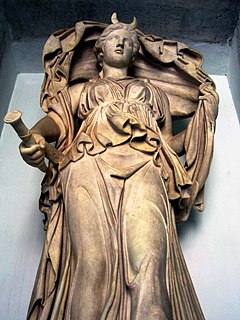
In ancient Roman religion and myth, Luna is the divine embodiment of the Moon. She is often presented as the female complement of the Sun, Sol, conceived of as a god. Luna is also sometimes represented as an aspect of the Roman triple goddess, along with Proserpina and Hecate. Luna is not always a distinct goddess, but sometimes rather an epithet that specializes a goddess, since both Diana and Juno are identified as moon goddesses.

Phaethon, also spelled Phaëthon, was the son of the Oceanid Clymene and the sun god Helios in Greek mythology. His name was also used by the Ancient Greeks as an alternative name for the planet Jupiter, the motions and cycles of which were personified in poetry and myth.

Agron was an Illyrian king of the Ardiaean Kingdom in the 3rd century BC, ruling c. 250–231 BC. The son of Pleuratus II, Agron succeeded in reconquering southern Illyria, which had been under the control of Epirus since the time of Pyrrhus, and in extending Illyrian rule over many cities in the Adriatic region, including Corcyra, Epidamnos, and Pharos.
John Lemprière was an English classical scholar, lexicographer, theologian, teacher and headmaster.
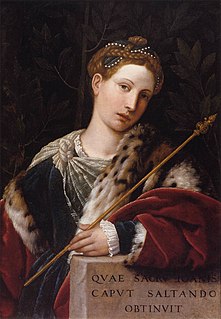
Tullia d'Aragona was an Italian poet, author and philosopher. Born in Rome sometime between 1501 and 1505, Tullia traveled throughout Venice, Ferrara, Siena, and Florence before returning to Rome. Throughout her life Tullia was esteemed one of the best female writers, poets, philosophers, and charmers of her time. Influencing many of the most famous male philosophers, Tullia's work raised the status of women to be on an equal footing as men. Her fame and success made her into the most celebrated of Renaissance poet-courtesans. With her intellect, literary abilities and social graces, she entertained powerful men and famous poets.
Tullia, sometimes referred to affectionately as Tulliola, was the first child and only daughter of Roman orator and politician Marcus Tullius Cicero, by his first marriage to Terentia. She was the sister of Marcus Tullius Cicero Minor, born in 65 BC, and who became consul in 30 BC.

Giuseppe Bartolomeo Chiari, also known simply as Giuseppe Chiari, was an Italian painter of the late-Baroque period, active mostly in Rome.

François-Guillaume Ménageot (1744–1816) was a French painter of religious and French historical scenes. A pupil of François Boucher (1703–1770), he went on to win the Grand Prix de Rome and become a director of the French Academy in Rome, an academician and a member of the Institute.

In ancient Roman mythology, Salacia was the female divinity of the sea, worshipped as the goddess of salt water who presided over the depths of the ocean. Neptune was her consort. That Salacia was the consort of Neptune is implied by Varro, and is positively affirmed by Seneca, Augustine and Servius. She is identified with the Greek goddess Amphitrite, consort of Poseidon.
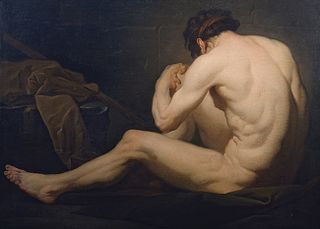
Michel François André-Bardon was a French history painter and etcher.
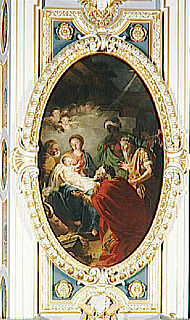
Jean Bardin (1732–1809) was a French historical painter.

Tullia Minor is a semi-legendary figure in Roman history. She was the last queen of Rome. The younger daughter of Rome's sixth king, Servius Tullius, she married Lucius Tarquinius. Along with her husband, she arranged the overthrow and murder of her father, securing the throne for her husband. Her actions made her an infamous figure in ancient Roman culture.

Tommaso Gazzarrini was an Italian painter born in Livorno, who painted religious and historic subjects in a Neoclassic style.
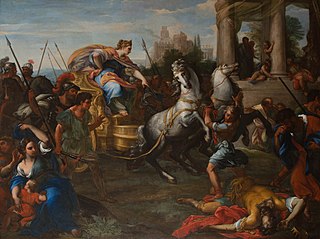
Tullia driving her Chariot over her Father is a 1687 painting by Giuseppe Bartolomeo Chiari which depicts the last Queen of Rome Tullia driving her chariot over the dead body of her father, King Servius Tullius. The work was commissioned by Jacopo Montinioni and was later purchased by John Cecil, 5th Earl of Exeter after the formers death. It is held today by the Burghley House Historic Trust.
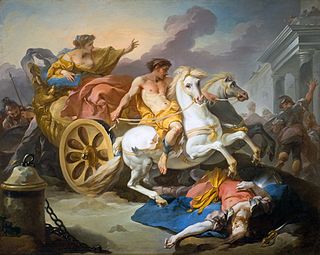
Tullia Running Her Chariot over the Body of Her Father is a 1735 painting by Michel-François Dandré-Bardon which depicts Roman princess Tullia running over her father King Servius Tullius's dead body with her chariot. Upon the submission of this work Bardon was accepted into the Académie royale de peinture et de sculpture.

Tullia Driving her Chariot over the Body of her Father is a 1765 painting by François-Guillaume Ménageot which depicts the Roman princess Tullia driving her chariot over the dead body of her father, the king Servius Tullius. The painting won second prize at the Prix de Rome.

















